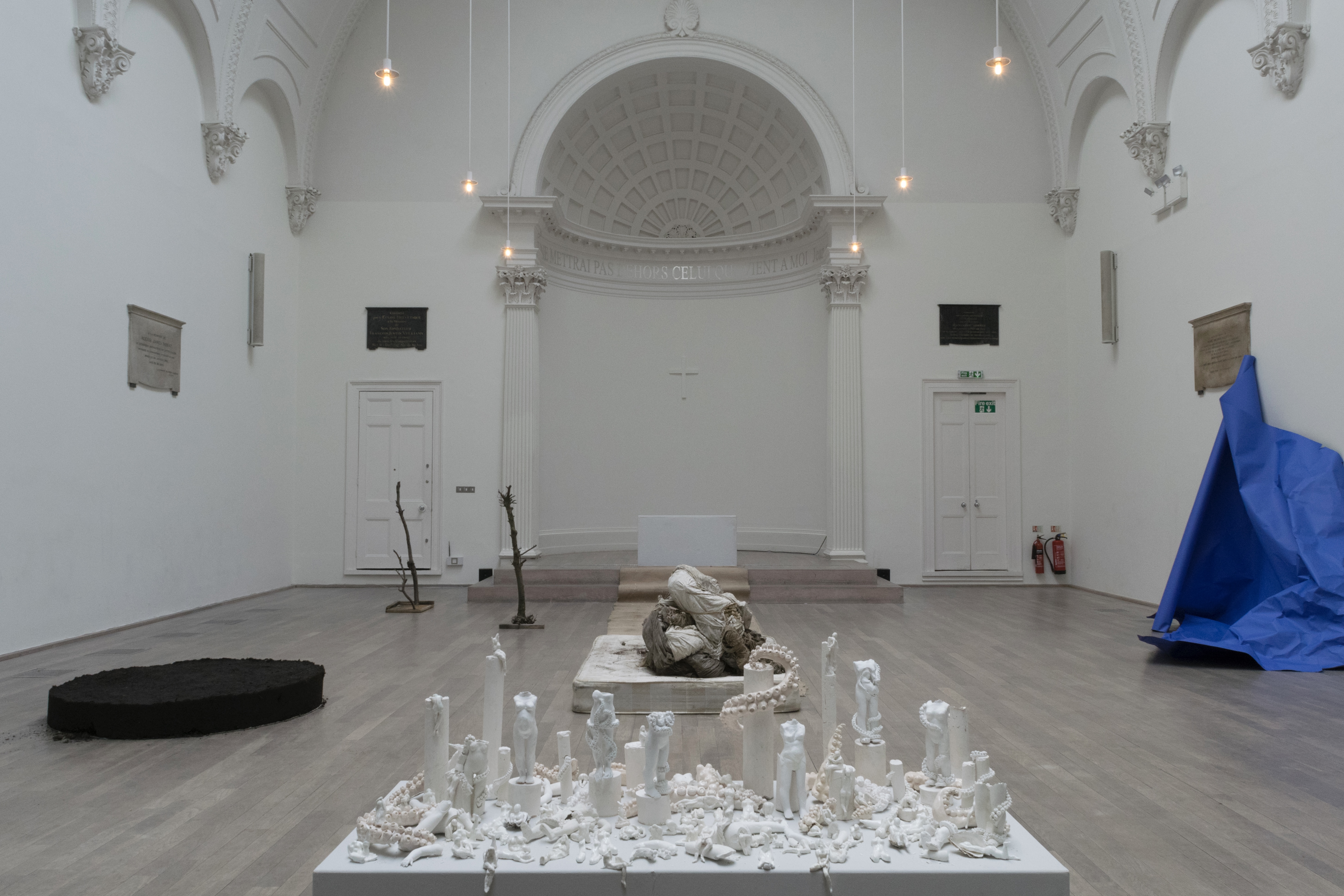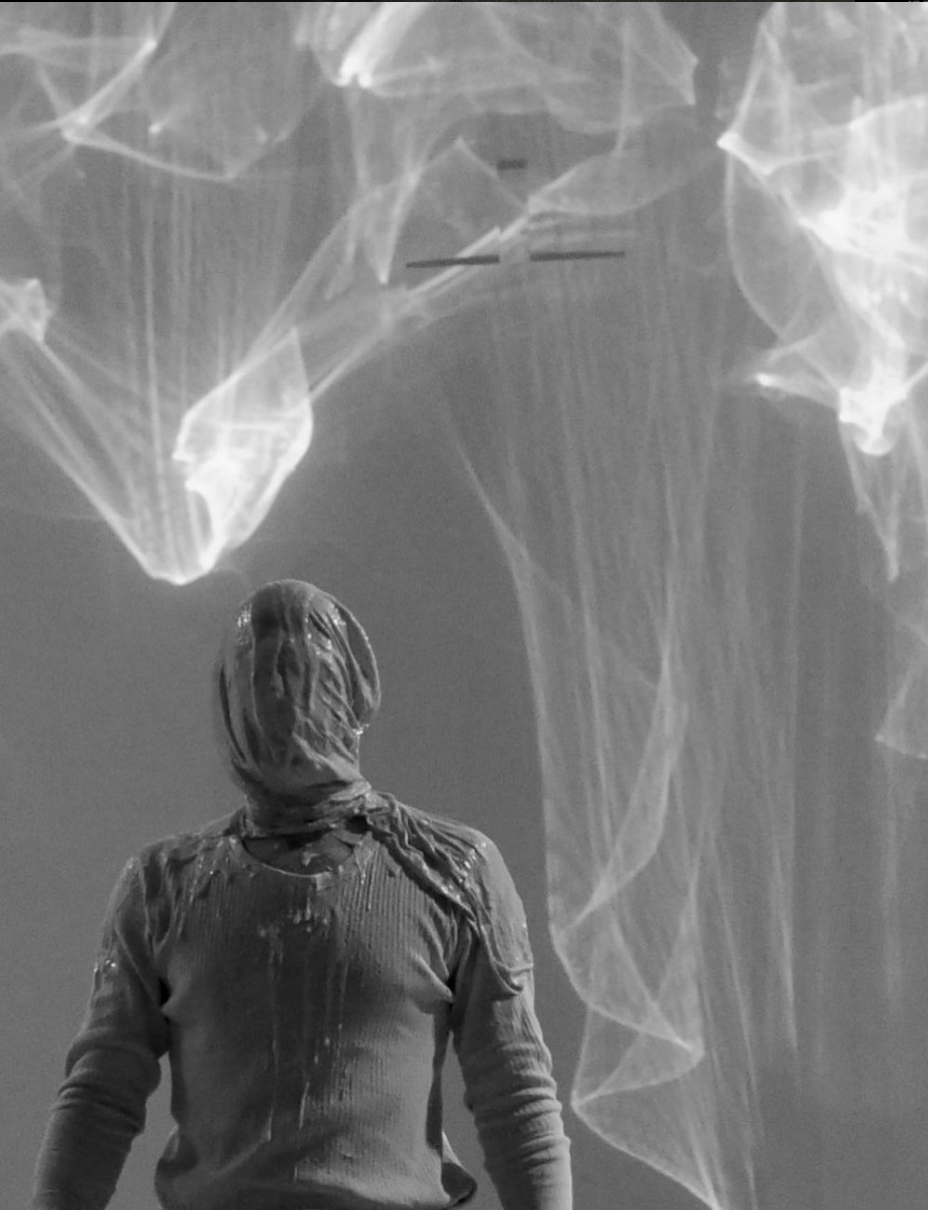In Nihilum
Swiss Church, London
Hannah Archambault, Ellen Barratt, Luke Jordan, Camille Hanney, Eloise Lawson, Hannah Walton
Through the works of six artists, In Nihilum reinvestigated the Genesis creation myth against the contemporary backdrop of the global environmental crisis. Examining the relationships between myth, artistic divinity, and the natural world, In Nihilum aimed to consider the creation of the world alongside the creation of art. Respectively embodying the accomplishments of each day of creation, the six bodies of work were removed, one by one, day by day, until we found ourselves in an empty space.
Through the physical removal of artworks, In Nihilum reversed the Genesis narrative. The gesture served as a metaphorical visualisation of the process of the destruction of nature, spirituality and myth. As per the Genesis myth, God created the world ex nihilo [from nothing], and so exhibition was created in nihilum [into nothing]. Despite this emptiness, it still left potential for hope: once the space is emptied of art, it returns to its original function as a church, a symbolic place of faith and redemption.
--
Day One
As God created men last, In Nihilum featured Luke Jordan’s performance Unformed (2020) to initiate the process of deconstruction. By creating ambiguous formations of sculpture, installation and sound, Jordan’s performance created a multi-layered speculative world, commenting on the creation of humankind and our material world.
Day Two
Camilla Hanney’s piece Mother, Madonna, Monster (2019) was witness to the existence of living creatures introduced by God on day Five. By materialising the familiar in an unfamiliar context, she stimulated our ability to rethink our relationship towards objects, threatening its natural order and toying with the tensions that lie between beauty and repulsion and curiosity and discomfort.
Day Three
Next in the reverse chronological order was the creation of Sun, Moon and Stars. Eloise Lawson used the sea as a starting point for her piece, for its status as the thing/place that connects us most powerfully to the behaviour and sensibility of the moon, but also for the appeal of its inherent volatility and unknowability. You’re continuously rearranging yourself (2020) considered how the inbuilt wavering or ambivalence of the sea might function as a metaphor for indecision or not-knowing more generally.
Day Four
As God created Land, Sea and Vegetation, In Nihilum presented the work of Hannah Walton. Entirely built from earth, Walton’s installation entitled Gather to Loose (one tonne) (2020) captured the disruptive capacity of attentive embodiment. She engaged with notions of power structures, surveillance and spatial relationships sculpturally through a focus on material and form, which allowed greater scope for complexity juxtaposed with a hint of confusion and incoherence.
Day Five
Symbolising the creation of Heaven and Atmosphere, Hannah Archambault’s sound installation O (2020) resonated with the spiritual identity of the Swiss Church. As atmospheric sound moved through the space from one area to another and back, O acted as a guide to explore the space and an invitation to engage not only with our bodies but also our listening.
Day Six
In Genesis, the first sign of life is Light. Last in order of dismantling the myth, Ellen Barratt’s New Light (2020) embodied an homage to light. The installation illuminated the curved, monumental wall behind the church’s altar, reacting to and with the space’s natural light balance. Barratt worked on the edge of materiality, using New Light to construct an immersive experience.
curated in collaboration with Francis Portugal.
Swiss Church, London
Hannah Archambault, Ellen Barratt, Luke Jordan, Camille Hanney, Eloise Lawson, Hannah Walton
Through the works of six artists, In Nihilum reinvestigated the Genesis creation myth against the contemporary backdrop of the global environmental crisis. Examining the relationships between myth, artistic divinity, and the natural world, In Nihilum aimed to consider the creation of the world alongside the creation of art. Respectively embodying the accomplishments of each day of creation, the six bodies of work were removed, one by one, day by day, until we found ourselves in an empty space.
Through the physical removal of artworks, In Nihilum reversed the Genesis narrative. The gesture served as a metaphorical visualisation of the process of the destruction of nature, spirituality and myth. As per the Genesis myth, God created the world ex nihilo [from nothing], and so exhibition was created in nihilum [into nothing]. Despite this emptiness, it still left potential for hope: once the space is emptied of art, it returns to its original function as a church, a symbolic place of faith and redemption.
--
Day One
As God created men last, In Nihilum featured Luke Jordan’s performance Unformed (2020) to initiate the process of deconstruction. By creating ambiguous formations of sculpture, installation and sound, Jordan’s performance created a multi-layered speculative world, commenting on the creation of humankind and our material world.
Day Two
Camilla Hanney’s piece Mother, Madonna, Monster (2019) was witness to the existence of living creatures introduced by God on day Five. By materialising the familiar in an unfamiliar context, she stimulated our ability to rethink our relationship towards objects, threatening its natural order and toying with the tensions that lie between beauty and repulsion and curiosity and discomfort.
Day Three
Next in the reverse chronological order was the creation of Sun, Moon and Stars. Eloise Lawson used the sea as a starting point for her piece, for its status as the thing/place that connects us most powerfully to the behaviour and sensibility of the moon, but also for the appeal of its inherent volatility and unknowability. You’re continuously rearranging yourself (2020) considered how the inbuilt wavering or ambivalence of the sea might function as a metaphor for indecision or not-knowing more generally.
Day Four
As God created Land, Sea and Vegetation, In Nihilum presented the work of Hannah Walton. Entirely built from earth, Walton’s installation entitled Gather to Loose (one tonne) (2020) captured the disruptive capacity of attentive embodiment. She engaged with notions of power structures, surveillance and spatial relationships sculpturally through a focus on material and form, which allowed greater scope for complexity juxtaposed with a hint of confusion and incoherence.
Day Five
Symbolising the creation of Heaven and Atmosphere, Hannah Archambault’s sound installation O (2020) resonated with the spiritual identity of the Swiss Church. As atmospheric sound moved through the space from one area to another and back, O acted as a guide to explore the space and an invitation to engage not only with our bodies but also our listening.
Day Six
In Genesis, the first sign of life is Light. Last in order of dismantling the myth, Ellen Barratt’s New Light (2020) embodied an homage to light. The installation illuminated the curved, monumental wall behind the church’s altar, reacting to and with the space’s natural light balance. Barratt worked on the edge of materiality, using New Light to construct an immersive experience.
curated in collaboration with Francis Portugal.
2 – 8 March 2020

Installation view: In Nihilum (2 – 8 March 2020) at Swiss Church, London. Courtesy of Kollektiv Collective and the artists. Photography by Hannah Archambault.
 New Light, 2020, by Ellen Barratt: In Nihilum (2 – 8 March 2020) at Swiss Church, London. Courtesy of Kollektiv Collective and the artists. Photography by Ellen Barratt.
New Light, 2020, by Ellen Barratt: In Nihilum (2 – 8 March 2020) at Swiss Church, London. Courtesy of Kollektiv Collective and the artists. Photography by Ellen Barratt. Mother, Madonna, Monster, 2020, by Camilla Hanney: In Nihilum (2 – 8 March 2020) at Swiss Church, London. Courtesy of Kollektiv Collective and the artists. Photography by Hannah Archambault.
Mother, Madonna, Monster, 2020, by Camilla Hanney: In Nihilum (2 – 8 March 2020) at Swiss Church, London. Courtesy of Kollektiv Collective and the artists. Photography by Hannah Archambault. Gather to loose (one tonne), 2020, by Hannah Walton: In Nihilum (2 – 8 March 2020) at Swiss Church, London. Courtesy of Kollektiv Collective and the artists. Photography by Hannah Archambault.
Gather to loose (one tonne), 2020, by Hannah Walton: In Nihilum (2 – 8 March 2020) at Swiss Church, London. Courtesy of Kollektiv Collective and the artists. Photography by Hannah Archambault. Unformed, 2020, performance by Luke Jordan: In Nihilum (2 – 8 March 2020) at Swiss Church, London. Courtesy of Kollektiv Collective and the artists.
Unformed, 2020, performance by Luke Jordan: In Nihilum (2 – 8 March 2020) at Swiss Church, London. Courtesy of Kollektiv Collective and the artists.